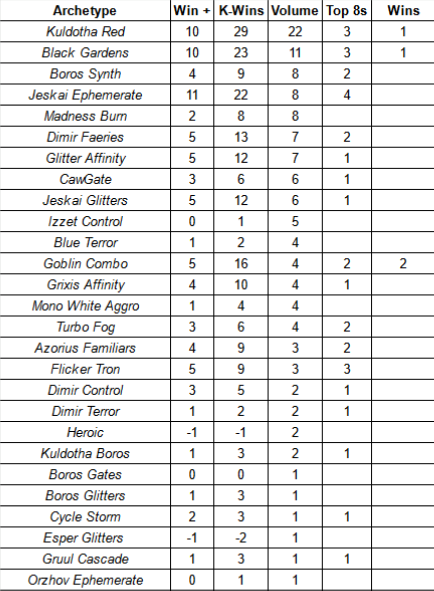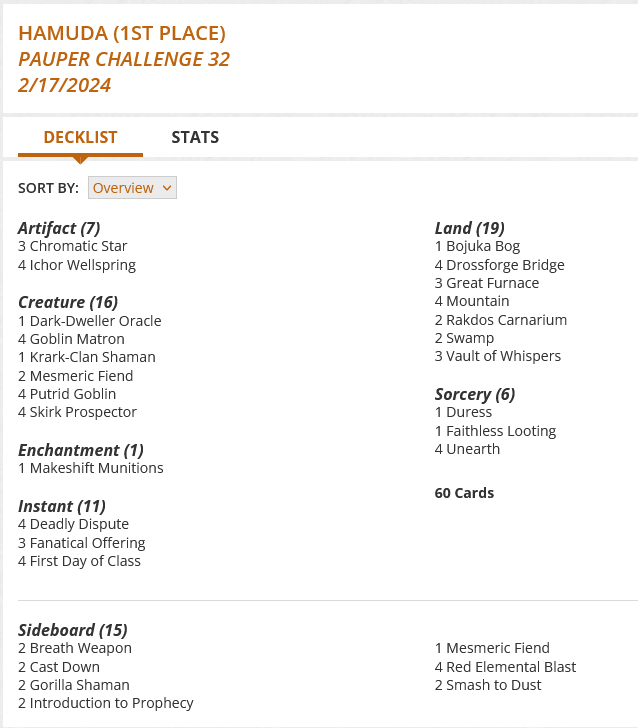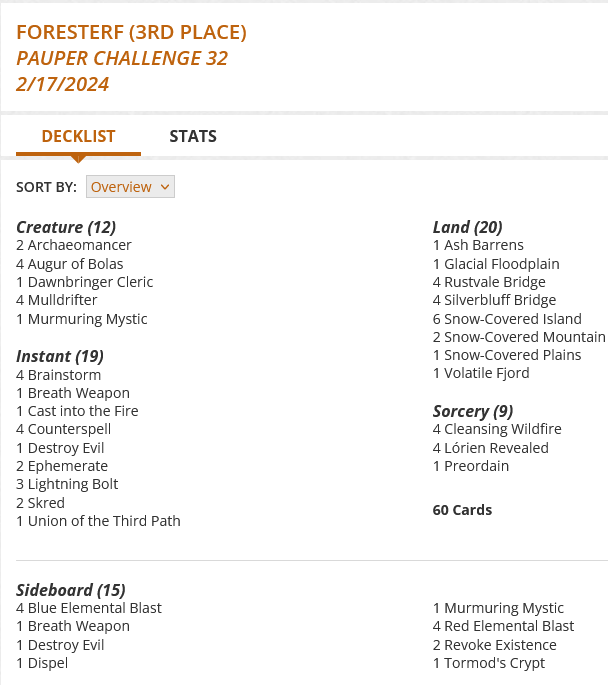I use a few different metrics when looking at the Top 32 metagame. The first is just Raw Volume. The second is Win+, which takes the sum of all wins at X-2 or better in the Swiss and assigns a score; Win+ is helpful in measuring a deck’s Swiss round performance. K-Wins takes all of a deck’s wins and subtracts its losses, Top 8 inclusive; this helps to give a measure of overall performance. The final pair is call Meta Score and Meta Score Above Replacement, which takes the average of Win+ and K-Win to try and position an archetype against its field. This number helps to provide the most robust image of a deck’s performance.
Okay right off the bat the title here is misleading as today’s post is going to be covering the first two weeks of Murders at Karlov Manor season. The weekend of February 10-11 saw an issue with Magic Online that completely borked the Sunday Challenges and as a result we didn’t get the, well, results. One event is not a lot to go on so I put off last week’s recap in favor of doing a more in depth one today. So today’s post is going to be look at the four of the first six Challenges of the recent season, taking into account 230 entrants. Let’s take a look at the overall metagame.

On first glance this looks like the kind of metagame that could make a somewhat prominent Pauper writer eat their words. Kuldotha Red was the most played deck over the first four recorded tournaments this season, coming it at over 18% of the overall metagame. And if that was the entire story I would be getting the ketchup ready. But the numbers don’t hold true – there’s a small drop in Kuldotha Red’s prevalence to 17.19% of the Top 32 metagame. The dip is even more stark in the winner’s metagame – a weighted measure that takes performance into account. There the number clocks in at a more reasonable 14.3%.
Taken together what we have is a deck that is popular and good, but also one that as the field narrows starts to see its performance drop relative to its popularity. There are a few other confounding factors to consider. First, we are in the early part of a release cycle where the highest impact new card skews aggressive, which means control decks are still in the process of adjusting. Second, Kuldotha Red is the clear best execution of a Red Deck in Pauper at the moment. For other strategies, whether it is the Initiative or seeks to leverage All That Glitters or Skred or Tolarian Terror all have multiple options. While there may be a clear best build of these strategies from week to week, Kuldotha Red will consistently at the top of its class. The result is red simply gets to accrue statistics over the course of a season. Again none of this is to say the deck is bad, just that it might not be as good as the raw numbers indicate.

This then begs the question of what decks are doing well? Black Gardens is outperforming its presence. At 8.7% of the overall metagame it actually takes a dip to 8.59% of the Top 32 metagame but jumps up appreciably to 10.47% of the weighted metagame. Over the four recorded events Black Gardens earned an adjusted Meta Score Above replacement of 0.7, beating out Kuldotha Red’s 0.53. But what was really surprising is that Black Gardens was the third best deck over the first weeks of the season.

Let’s start with the second best performing deck on the weekend – Goblin Combo. Goblin Combo is a persist combo deck that uses Skirk Prospector, Putrid Goblin, and First Day of Class to generate an unbound amount of mana. Once this is achieved the deck can then convert that mana into pings with Makeshift Munitions to win the game. All of this is stitched together with Goblin Matron and Dark-Dweller Oracle, with Oracle allowing you effectively draw your entire deck. Recently the deck has also adopted Mesmeric Fiend as a piece of maindeck disruption.
Goblin Combo has been around for quite some time but has never really taken off. This may be do to the number of clicks required to accomplish the combo on Magic Online, which can be onerous as you are not able to “demonstrate a loop” in the client. The deck also relies heavily on the graveyard and as such is vulnerable to all the regular hate that crops up. That being said the deck has the ability to deal as much damage as it needs to in order to win the game and unlike other combo decks in the format can win on the opponent’s turn (given the correct set of circumstances).
Over the tracked challenges, Goblin Combo earned an aMSAR score of 0.86. It accounted for 3.5% of the overall metagame and 5.88% of the Top 32 metagame, dipping down to 5.57% of the winner’s metagame. With the abundance of aggressive decks, control builds are skewing towards removal but Goblin Combo comes packed with enough resilience and redundancy to survive until it can turn the corner.

Jeskai Ephemerate has been the best performing deck thus far this season with aMSAR score of 0.94. The strategy is 5.2% of the overall Challenge meta, 6.25% of the Top 32 metagame, and then takes a leap up to 9.92% of the winner’s metagame. Jeskai Ephemerate is making a play for the premier control deck in the format currently due in no small part to its tool box nature.
Based around the Archaeomancer–Ephemerate engine, the goal of this deck is to see as many cards as possible and find the correct ones for a given situation. Mana hungry, Jeskai Ephemerate uses Cleansing Wildfire to accelerate while also seeing more cards. The addition of Murmuring Mystic to the format has provided a consistent win condition that can close out games quickly when needed while also absorbing damage from decks looking to turn sideways.
Part of the strength of Jeskai Ephemerate is in its flexibility. It can adjust its maindeck composition for an expected metagame, meaning the opponent can never be certain what is in store for them. Like Goblin Combo these builds are somewhat vulnerable to graveyard hate but at the same time they can just play a normal control game and sidestep Relic of Progenitus. The result is a deck that has the capability for just about anything, including falling on its face if it brings the wrong answers to the table.
The story of Murders at Karlov Manor season thus far looks to be one of folks preparing for aggression. Despite the popularity of beatdown strategies, the best performing decks to this point have been those designed to not only handle aggro but also have a plan to get around defenses. Whether it be through Trap, Munitions, or a never ending stream of Bird tokens, Pauper is not just about beating creatures on the board but figuring out a way around some well laid defenses.
Looking ahead I would be in the market for making Pestilence or Crypt Rats work. Provided such a deck could survive the early onslaught of red, these cards do a good job of keeping the board clear. Pestilence can also put in work, keeping Goblin Combo from going off and mitigating the damage from Murmuring Mystic. The issue with these decks, as always, is surviving to that point and then turning the corner. It is possible that a Basilisk Gate–Guardian of the Guildpact build could put in the work but then you are relying on multiple four drops to get things done, which does seem like a fairly large ask these days. Still, figuring out how to spread the sickness seems like a path worth pursuing for the upcoming Challenges.
I want to take a moment to thank all my Patrons – both old and new. I am going to do my level best to keep providing you with the kind of content that brought you here in the first place. If you are interested in supporting my work, rewards for my Patreon start at just $1 and every little bit helps.
Can’t make a commitment to Patreon? I now have a Ko-Fi where you can make a one time contribution.
Looking for another way to support my work? Click here for my TCGPlayer affiliate link. Any purchases through the link let the folks there know you like my content!
